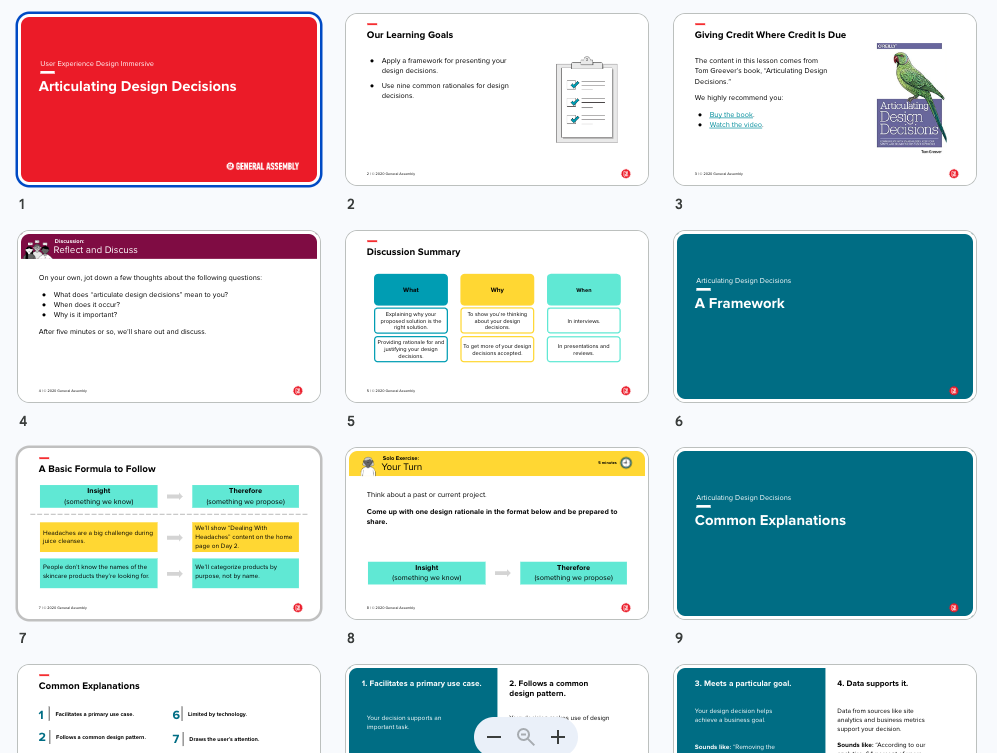
Leading a Group of Learners through Uncertainty: Teaching UX Design at General Assembly
First, some context
After completing my own UX Design Immersive experience, one of my instructors recommended me as an Instructor Associate. I began working with my first cohort at General Assembly in 2020 and continued teaching there for over a year.
In January 2021, I was recruited to replace one of the lead instructors who unexpectedly needed to leave midway through the program.
This presented a unique opportunity to quickly build trust with students who were in a potentially precarious situation.
I used differentiated instruction and actionable feedback to help students adjust to a new instructor in a fast-paced environment.
Establishing Credibility and Alleviating Anxiety
What I did…
Built trust and confidence with the students
Introduced myself and gave an overview of my experience, specifically with General Assembly
Outlined my role and how I would support students
Conducted individual assessments
Interviewed students about their abilities and experience levels
Discussed student expectations
Noted areas of interest within the wide spectrum of UX design
Plan of action - Tailored content
Planned presentations and materials appropriate for the group’s skill and interest level
Used data of individual skill sets to balance members for group projects
Incorporated knowledge of individual student’s interest in design to add supplemental materials to the daily agenda
General Assembly student
“Allison has given me the best and most in-depth feedback of my project so far and I really appreciate the time she takes to think deeply and make thoughtful comments to help make the project better.”
Differentiated Instruction
I supported students to meet their individual needs as well as enjoy a successful experience by structuring materials and directing my presentations to bolster a beneficial experience.
I worked with a student who needed extra support because they were new to design and an English learner. Each week, I would find current articles about relevant design principles, assign them to the student and discuss their meaning at the end of the week. User flows were particularly challenging, but after we spent extra time discussing scenarios where their use was beneficial and walking through existing user flows in detail, the student graduated with excellent understanding.
Another student was a brilliant visual designer with a background in graphic design, but they struggled with some of the more research-heavy concepts. We engaged in interview role-playing activities to drive home what can turn a good question into a great question. We also incorporated whiteboard challenges into our curriculum to practice dynamic thinking in critical situations.
“Allison's office hours were critical to the direction of my progress!”
GA Student
“I have found Allison to be very accessible and helpful right from the get-go which is impressive because she came in after the class started.”
GA Student
“Allison has provided me with some really specific and helpful feedback on my homework so far, and again I found her really helpful in office hours. Thanks, Allison.”
GA Student
Actionable Feedback
There were five presentations assigned throughout the course. It was common to encounter students who had never presented before, more specifically, never presented to audiences about making design decisions. I coached many students individually and in groups on how to craft impactful presentations. I asked them what they thought should be included and why. Then we would dig deep into their research, artifacts, and, explanations, concluding in carefully articulated design narratives that spoke to the intended audience.
Some students had limited experience working in groups which would inevitably lead to miscommunication and frustration among members. I helped these groups navigate challenging dynamics by reviewing shared expectations and reinforcing their understanding of design thinking principles. Scope creep was a common issue that ultimately served as a good reminder to continually revisit the shared definition of the problem each project was attempting to solve.
Instructors would provide feedback after each presentation in front of the rest of the class. It was important to be articulate with our critiques to ensure that the actionable feedback was valuable to the presenters as well as the rest of the class. Providing feedback in this context was another opportunity for me to connect and demonstrate the concepts and sequence of the design process.
Impact and Outcomes
All of the students graduated from this cohort to start their careers in user experience design. The lead instructor and I consistently received high instructor ratings derived from a weekly survey.
During my tenure as an instructor, I taught the fundamentals of design thinking but I also made sure to emphasize the importance of zooming out to look at the big picture and to think deeply about the whys and the hows of the decisions they were making.
I regularly have past students reach out to me for feedback on projects and their portfolios. The connections I made were invaluable and I will always look back at this time fondly.
Notes from my students on the last day of class








